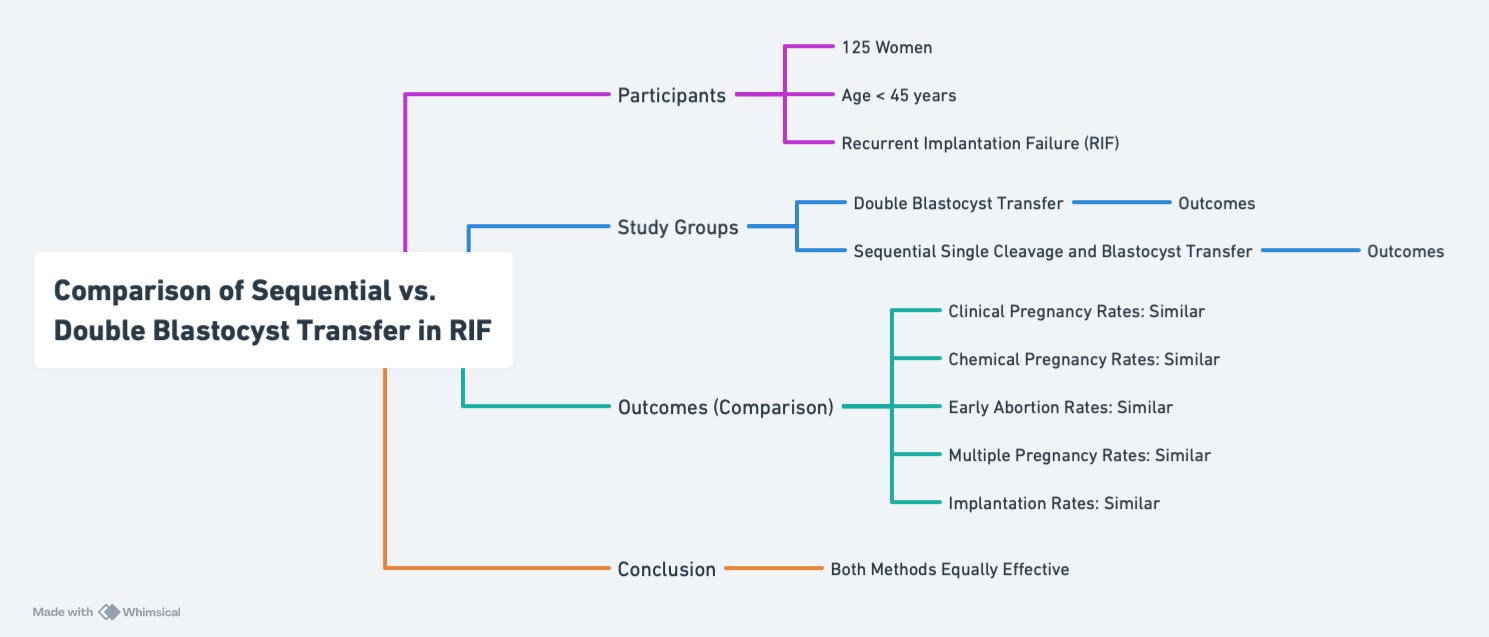Tue, Dec 9, 2025
[Archive]
Volume 23, Issue 4 (April 2025)
IJRM 2025, 23(4): 313-322 |
Back to browse issues page
Ethics code: IR.SSU.RSI.REC.1402.020
Download citation:
BibTeX | RIS | EndNote | Medlars | ProCite | Reference Manager | RefWorks
Send citation to:



BibTeX | RIS | EndNote | Medlars | ProCite | Reference Manager | RefWorks
Send citation to:
Hatamizadeh N, Eftekhar M, Aminimajomerd Z, Moeinaddini S. Comparison of double blastocyst transfer versus sequential transfer on pregnancy outcomes in individuals with frozen embryo transfer and a history of recurrent implantation failure: An RCT. IJRM 2025; 23 (4) :313-322
URL: http://ijrm.ir/article-1-3535-en.html
URL: http://ijrm.ir/article-1-3535-en.html
1- Research and Clinical Center for Infertility, Yazd Reproductive Sciences Institute, Shahid Sadoughi University of Medical Sciences, Yazd, Iran.
2- Research and Clinical Center for Infertility, Yazd Reproductive Sciences Institute, Shahid Sadoughi University of Medical Sciences, Yazd, Iran. ,eftekhar@ssu.ac.ir
2- Research and Clinical Center for Infertility, Yazd Reproductive Sciences Institute, Shahid Sadoughi University of Medical Sciences, Yazd, Iran. ,
Abstract: (1049 Views)
Background: Recurrent implantation failure poses a significant challenge in assisted reproductive technology despite the transfer of high-quality embryos over multiple cycles.
Objective: This study aimed to compare the clinical outcomes between double blastocyst transfer and sequential single cleavage-stage and blastocyst transfer in individuals undergoing frozen embryo transfer and those with a history of repeated implantation failure.
Materials and Methods: This randomized clinical trial was conducted at the Yazd Research and Clinical Center for Infertility, Yazd, Iran from February to November 2024 and included 125 women (< 45 yr) with a history of more than 2 implantation failures. Participants were randomized into 2 groups: one receiving double blastocyst transfer and the other receiving sequential single cleavage-stage and blastocyst transfer. The primary and secondary outcomes included clinical pregnancy, chemical pregnancy, early abortion, multiple pregnancy, and implantation rates.
Results: Baseline characteristics were similar between the 2 groups. Chemical pregnancy rates were comparable (51.6% for double blastocyst transfer vs. 49.2% for sequential transfer, p = 0.790), as were clinical pregnancy rates (46.9% vs. 44.3%, p = 0.769). Early abortion rates showed no significant difference (27.3% vs. 20%, p = 0.498). Multiple pregnancy rates were similar (23.3% vs. 25.9%, p = 0.820), and implantation rates did not differ significantly (28.9% vs. 27.86%, p = 0.889).
Conclusion: This study demonstrated that sequential single cleavage-stage and blastocyst transfer does not significantly improve assisted reproductive technology outcomes compared with double blastocyst transfer in individuals with recurrent implantation failure. Both methods had similar efficacy rates in terms of chemical pregnancy rates, clinical pregnancy rates, early abortion rates, multiple pregnancy rates, and implantation rates.
Objective: This study aimed to compare the clinical outcomes between double blastocyst transfer and sequential single cleavage-stage and blastocyst transfer in individuals undergoing frozen embryo transfer and those with a history of repeated implantation failure.
Materials and Methods: This randomized clinical trial was conducted at the Yazd Research and Clinical Center for Infertility, Yazd, Iran from February to November 2024 and included 125 women (< 45 yr) with a history of more than 2 implantation failures. Participants were randomized into 2 groups: one receiving double blastocyst transfer and the other receiving sequential single cleavage-stage and blastocyst transfer. The primary and secondary outcomes included clinical pregnancy, chemical pregnancy, early abortion, multiple pregnancy, and implantation rates.
Results: Baseline characteristics were similar between the 2 groups. Chemical pregnancy rates were comparable (51.6% for double blastocyst transfer vs. 49.2% for sequential transfer, p = 0.790), as were clinical pregnancy rates (46.9% vs. 44.3%, p = 0.769). Early abortion rates showed no significant difference (27.3% vs. 20%, p = 0.498). Multiple pregnancy rates were similar (23.3% vs. 25.9%, p = 0.820), and implantation rates did not differ significantly (28.9% vs. 27.86%, p = 0.889).
Conclusion: This study demonstrated that sequential single cleavage-stage and blastocyst transfer does not significantly improve assisted reproductive technology outcomes compared with double blastocyst transfer in individuals with recurrent implantation failure. Both methods had similar efficacy rates in terms of chemical pregnancy rates, clinical pregnancy rates, early abortion rates, multiple pregnancy rates, and implantation rates.
Keywords: Assisted reproductive technology, Repeated implantation failure, Blastocyst transfer, Sequential embryo transfer, Pregnancy rates.
Type of Study: Original Article |
Subject:
Fertility & Infertility
Send email to the article author
| Rights and permissions | |
 |
This work is licensed under a Creative Commons Attribution-NonCommercial 4.0 International License. |








